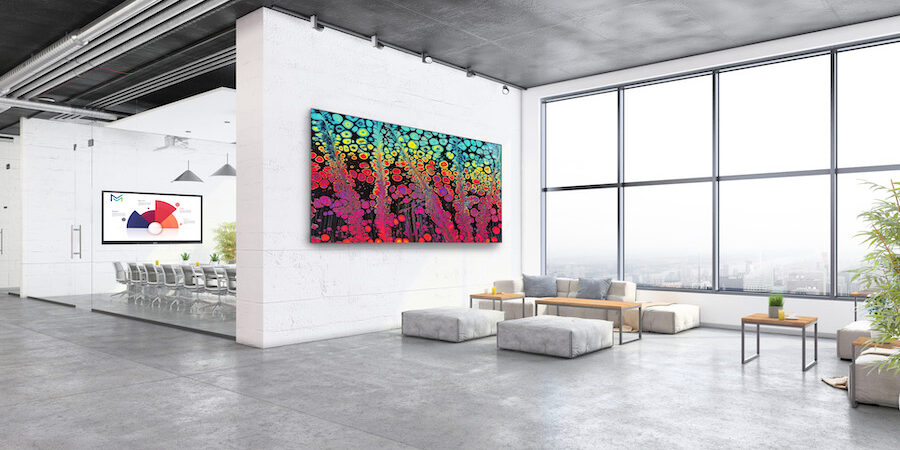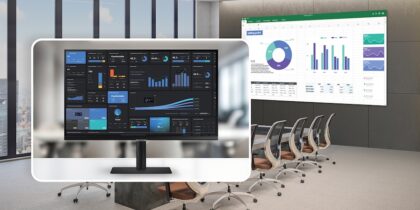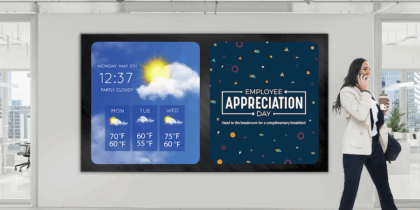Projectors used to rule the roost in all sorts of commercial display applications, but the new boss is the LED wall. In meeting rooms, classrooms, lobbies, retail showrooms and even government command centers, LED walls like Samsung’s All-in-One LED IAC have rapidly replaced projectors as the display of choice.
Laser projector vs. LED
An obvious difference between a projector and an LED is in visual performance.
Projectors work by shining a light through a small transparent lens onto a surface. Viewers see the reflection of the projected image. Projectors perform better in a dark environment because the light of the projector is not particularly bright and it has to travel from the projector to the screen. They also generate a fair amount of heat, which is why projectors require a fan and tend to be noisy.
Digital signage content management made easy
Conversely, the All-in-One LED IAC screen is made up of components that emit light directly toward the viewer. The light has virtually no distance to travel, so the resulting image is extremely bright and clear. Even viewed from an angle or in brightly lit rooms, the screen loses none of its sharpness, brightness or coherence, making it perfect for big meeting rooms.
Samsung’s cutting-edge microLEDs, the next generation of LEDs that power The Wall for Business, are submillimeter-size chips that produce a dynamic color range and higher contrast, for more vivid and precise visuals than normal LEDs. Unlike with projectors, there’s no need to dim the lights to see all the details on an LED screen. Meeting rooms can remain well-lit during presentations, allowing employees to take notes, remain more attentive and, for remote employees joining via web conferencing, see the room and meeting attendees clearly.
Replacing a projector with an affordable LED video wall
Even facilities designed around a projector-based system can easily upgrade to a microLED wall. The flexible, modular nature of LED allows you to tailor the solution to any space. Removing a bulky projector and an even bulkier screen also frees up valuable space; from planning to installation, your LED display is working for you rather than the other way around.
LED video walls also tend to be easier to use and connect devices to, as one medical research university in Oklahoma City discovered when they made the switch to LED after their projector caught fire. With high-quality visuals and no need for maintenance, Samsung’s All-in-One LED IAC wall was an obvious choice for an affordable LED video wall for the campus.
As you consider laser projector vs. LED, here are some things to keep in mind:
Designing around your space
Think of your LED wall as a series of tiles or modules that fit together — seamlessly — in order to fill the allotted space. As you measure your space and plan the video wall’s design, keep in mind that the only space your new solution will need is for the display itself. A wall-mounted display is a lot more practical and effective than the projector equivalent, which needs space both for the screen and the projector. Projectors also depend on access to the power grid, which often comes with obtrusive cables. LED walls are far more discreet, powered without cables running across the floor.
How to plan and deploy direct view LED signage
Everything you need to know about choosing your LED displays for optimal viewing indoors and out. Download Now
Selecting the right technology
Pixel pitch, the distance between the center of one “tile” and the center of the next, is also a critical consideration. If you need your LED wall to be crisp and legible from a significant distance — in a hotel lobby, for instance — there should be a relatively large distance between the pixels (a higher pixel pitch). But a higher pixel pitch doesn’t look great up close, such as in a home theater. In this instance, the pixels should be closer together (a lower pixel pitch), and the screen will therefore have more pixels in total. Cost increases with the number of pixels, so identically sized LED tiles can vary significantly in price.
Finding a trusted installation partner
Once you’ve invested in an LED wall, it needs to be properly installed. It’s easy to find an installation service, but it’s a little trickier to find a reputable provider you can trust. You want your new LED wall to be calibrated correctly, and hiring a professional helps ensure the job is done to a high standard. Samsung provides white glove service and support through your display installation, as well as regular maintenance, ensuring all your LED panels perform exactly as they should.
Making the investment
A new LED wall is likely to be less of an investment than you’d expect. When you consider a laser projector vs. LED’s longevity, you would likely replace a projector two or three times over before needing a new LED wall.
LED is an obvious upgrade from a projector in every respect — from ease and flexibility of installation to lack of maintenance and out-and-out performance. Ultimately, there’s no appreciable downside. As a business investment, the advantages of microLED technology are obvious. And for the end user, it’s a far more engaging and satisfying viewing experience.
Discover the All-in-One LED IAC display, and enjoy its brilliant performance. And find everything you need to know about choosing your LED displays for optimal viewing indoors and out in this free comprehensive guide.









